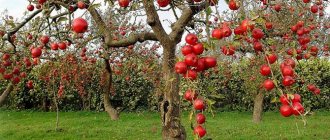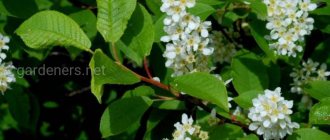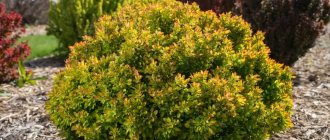General description of gooseberries
The gooseberry plant is considered a perennial prickly shrub berry plant. Gooseberries grow to a height of approximately 1-1.5 m. As a rule, this plant begins to bear fruit a few years after planting, and with proper care it can bear fruit for up to 30 years.
It is worth noting that most gooseberries have thorns, but there are varieties that do not have them. The flowering period begins in April and self-pollinates.
Gooseberry berries can be oval, round or pear-shaped in shape, with a size of approximately 12-40 mm.
The color can be yellow, green, red and almost black, and the taste is sweet and sour with a specific aroma. The period of fruit ripening occurs from June to August.
Distribution area
Where do gooseberries grow? In the wild, the plant is distributed in Transcaucasia, North America, Central Asia, Ukraine, Europe, and North Africa.
In Russia, the crop is grown in gardens in the middle zone. The seeds are carried by birds, and wild bushes are found in the forests of Bryansk, Tver, Saratov, Kostroma, Oryol, Moscow, Vladimir, Voronezh, Kaluga, Tula, Samara, and Ulyanovsk regions.
Wild gooseberries grow on rocky mountain slopes among other shrubs, in swampy forests, wastelands and abandoned farmland.
The crop is grown as a fruit and berry plant on light, medium loamy, fertile soils. Ribes uva-crispa loves moisture, but does not develop well in areas with close groundwater.
Popular gooseberry varieties
Gooseberries have a very wide range of varieties, which differ in ripening period, size and even taste. Experts distinguish 2 categories of gooseberries: with and without thorns.
In turn, thorned gooseberries are divided into yellow, green and red, and each category distinguishes its best gooseberry varieties.
A brief description of the most popular gooseberry varieties and suitable for cultivation by color:
Harvesting
Gooseberries can be picked at different degrees of ripeness, which stretches and makes harvesting somewhat easier. The degree of ripeness at which gooseberries are harvested depends on weather conditions, soil moisture and the variety. For example, varieties Russian and Pink can be harvested at varying degrees of ripeness. The berries of these varieties have high technological qualities and are suitable for various types of processing. The Smena variety can be picked at full ripeness - the berries of this variety hang on the bush for a long time without falling off. In the varieties Krasnaya Zarya, Russian, and Pioneer, the berries can also be stored on the bush until they are fully ripe, since these varieties are more drought-resistant than Date and Moscow Red, and their berries do not lose weight so much in dry years. Early dessert varieties with thin skin (Moscow Red) are collected in small containers (up to 2-3 kg); for berries with thick skin (dates), boxes or baskets with a volume of 10-15 kg are suitable. Gooseberries tolerate long-distance transportation well, but it is not recommended to pour berries from one container to another - this reduces their quality.
Yellow varieties
They are considered the sweetest and juiciest, among them are:
Honey
A very sweet variety, notes of May honey are noticeable in the taste. The berries are not too large in size, with a soft and thin film, so they are very difficult to transport and store for a long time. It is worth noting that this variety is very susceptible to pests and various diseases.
Russian yellow
It has characteristic rather large oval berries, which are covered with a thin layer of wax. This variety pollinates very well, so if you want to plant several varieties of gooseberries, you should keep a distance of about 1.5 m between them.
Amber
One of the most beautiful varieties, ripens very early. The berries are oval-shaped and yellow or orange in color.
It is worth noting that this variety grows up to 1.5 m in height and has a large number of sharp spines.
The most unpretentious
These varieties will be especially relevant for gardeners doing what they love in harsh climate zones. Most resistant varieties are hybrids, that is, they were specially bred for growing in difficult conditions.
Eaglet
Many consider it the best gooseberry variety. The Eaglet earned this fame due to its high yield (8 kg), resistance to unfavorable climate and excellent taste.
The size of the berries ranges from 4 to 6 g depending on the weather and care. The color of the pulp is crimson. This is an early fruiting variety that is resistant to powdery mildew. The eaglet is compact and has a small number of spines.
Sirius
Gooseberry variety of medium-late ripening. The bush is upright, reaches 2 m in height, shoots with a small number of thorns grow vertically. The berries are medium size (4 g), round in shape, dark red, sweet and sour taste. The average yield per plant is 2.5–3.0 kg.
Sirius is winter-hardy and drought-resistant, but can be affected by powdery mildew.
Aristocrat
The variety was developed by crossing Sirius with sweet Prune. Thanks to this, it inherited resistance to pests and harsh climatic conditions, coupled with heavy (up to 7 g) fruits.
Ripe berries have a dark ruby, almost black hue. The bushes are tall, spreading, and occupy enough space. The ripening period is medium-late, the yield reaches 4 kg.
The variety is resistant to major gooseberry diseases, including powdery mildew, winter-hardy, shoots with a small number of thorns. The downside is the unstable mass of berries.
Strawberry
Gooseberries are characterized by high winter hardiness, which allows them to be grown in regions with unfavorable climates. The bushes are medium-sized (up to 1 m), spreading. Shoots with many thorns.
Light green table berries with a pink side surprise with their bright strawberry flavor. Tasting score 4.9 points, fruit weight up to 5 g.
The ripening period is mid-early, the yield is average. High self-fertility, resistance to powdery mildew.
Green varieties
They have both sour and sweet tastes, the most popular are:
Malachite
The berries of this variety are large, oval-shaped and with a slight coating of wax. There are a large number of seeds inside the berry. These gooseberries are sour in taste, but if you let them overripe a little, they will become sweet and juicy.
Belorussian
One of the most compact gooseberry varieties. The fruits are very large, with a thin skin and have a sweet and sour taste. When harvesting, it is worth remembering that this variety has a lot of thorns.
Ural emerald
A photo of this variety of gooseberries immediately catches the eye on the large, hairless berries, which is not typical for other varieties. This variety tolerates severe frost best and has a small number of thorns. It is worth noting that the first harvest occurs 3 years after planting.
Gooseberry in folk medicine
Researchers and herbalists consider gooseberries (especially dark varieties) even more beneficial than apples, cherries or raspberries. Here are some treatments using gooseberries.
For anemia, vitamin deficiency, and skin rashes, it is recommended to drink gooseberry juice with a little honey. Improvement of the condition is predicted after 4-5 weeks of treatment. Juice from the berries can be obtained using a regular juicer or by adding a small amount of water to the crushed berries. Berry juice will also help remove toxins and excess fats from the body. But in this case, drink the drink diluted 1:2 with water. Juice and honey will also help with sore throats and colds. You can drink this delicious drink or gargle with it. Previously it was believed that gooseberry juice treats malaria and all types of inflammation.
Gooseberry decoction has a mild laxative and analgesic effect. Pour a glass of boiling water over a spoonful of berries and cook over very low heat for 10 minutes. The chilled and strained drink is consumed in a glass 4 times a day. The same decoction is suitable for treating skin burns resulting from contact with poisonous plants. Apply the liquid to damaged skin several times a day. The therapeutic “compote” quickly relieves pain and accelerates healing. But only ripe berries are suitable for preparing medicine. Fresh fruits or a decoction of them are also useful for women with menstrual irregularities.
In folk medicine, not only berries are used, but also gooseberry leaves. So 25 g of dry leaves, brewed with half a liter of boiling water, are useful for removing kidney stones. It is recommended to take a glass of this medicine three times a day (but only after consulting a doctor).
Red gooseberry varieties
The most popular among gardeners. The ones who won the most love were:
Date fruit
It has the largest fruits, the weight of each berry is approximately 15 g. It has a rather dense crust and a large number of thorns. The ripening period comes late, does not tolerate dry soil well and is easily susceptible to pests and diseases.
Kolobok
It has short spines in very small quantities. It produces a large harvest, rarely gets sick and is practically resistant to pests.
Chernomor
A variety that has virtually no thorns. The fruits are small, oval in shape, almost black in color. This variety is one of the unpretentious ones, but it gives an average yield.
Among thornless gooseberries, the following varieties are distinguished:
Grushenka
This variety has a high yield, tolerates dry soil well and is resistant to many diseases. The berries are not too large, but taste sweet. Depending on the degree of ripening, they may be red or purple in color.
Ural thornless
It has large and sweet berries, while the skin is thick and sour in taste. It is worth noting that if the harvest is not harvested on time, the ripe berries quickly fall off.
Weed control in the gooseberry bush zone in autumn
After cleaning the bite area, you may find weeds crushed with a rake. Wheatgrass can often be seen in large numbers. This plant has a depressing effect on gooseberries, so it must be exterminated.
To destroy wheatgrass, contact herbicides are suitable, preparations whose effect occurs after the poison comes into contact with the plant. If we are talking about a small number of berry bushes, after rainfall or watering, you can try to pull out the wheatgrass by hand. A small scoop is suitable for this. You must try to capture the roots as much as possible. If only a small part of it remains in the ground, the wheatgrass will begin to grow again.
Where and how to plant gooseberries
In principle, gooseberry seedlings can be planted in spring or autumn. Regardless of when to plant gooseberries, it is necessary to prepare the soil and get rid of all weeds. For planting, it is best to choose a sunny and spacious place.
Gooseberry seedling planting plan:
- Prepare the soil, fertilize it.
- Dig a hole corresponding to the size of the seedling.
- Cut off all dried roots and branches on the seedling, leaving 5 buds.
- Place the bush in the hole slightly at an angle.
- Compact the soil and water thoroughly.
Seasonal pruning of the bush
Pruning is carried out twice a year - in spring and autumn. The procedure cannot be carried out in the summer, because the gooseberry quickly forms a large number of new branches, so the procedure will be useless.
Spring
Spring pruning of gooseberries is carried out even before the buds bloom on the bush. Gooseberries awaken very early - as a rule, buds begin to swell on them already in the second half of March, and the first leaves appear at the end of March - beginning of April. If you want to prune in the spring, then it is important to do this before the sap begins to flow in the trunk - if possible, in the first ten days of March. It is not recommended to injure shoots with budding leaves - this will significantly weaken the plant, and therefore reduce its yield.
- Remove old branches (as a rule, they are almost black) and horizontal growth.
- Thin out the bush: cut off non-viable and defective (twisted, broken) stems. Clean the center of the bush well from young, weak shoots and barren, vigorous branches.
- Cover large cuts. For this purpose, use garden varnish.
Video: spring pruning of gooseberries
Autumn
If you do not have the opportunity to prune gooseberries in the spring, then you can do it in the fall. It is not recommended to carry out shortening pruning in early autumn: this can affect the growth of new shoots, which will not have time to become woody before the onset of cold weather and will die. Therefore, autumn pruning is carried out during the period beginning after the harvest and the fall of leaves and continuing until the onset of cold weather.
- Inspect the bush and completely remove all blackened shoots.
- Thin out the bush: eliminate non-viable and defective branches (bent, diseased, broken), as well as inconveniently located ones (for example, protruding strongly from the general bush or hanging low above the ground). Try to clear the middle of the bush as much as possible to get rid of newly formed shoots and low-yielding, vigorous branches.
- Be sure to use a garden varnish to cover large cuts.
Related article: Fritillaria flower or hazel grouse: description and features of plant care
Remember that the maximum number of cut branches should not exceed 1/3 of their total number.
Video: autumn pruning of gooseberries
Pruning gooseberries does not pose any difficulties and can be done even by a novice gardener. The main thing is to carefully and timely follow all the recommendations for carrying out this event, and the bush will respond to this with health and a bountiful harvest.
Gooseberry care
If you follow all the rules for planting and caring for gooseberries in open ground, they will bear fruit for many years. Among the rules of care, the following stages are distinguished:
Pruning is necessary every year after the basal shoots appear. Only 3-5 shoots should be left. You also need to trim off all dried or diseased parts of the plant;
Soil care consists of loosening the soil, removing weeds;
Watering is one of the most important components of gooseberry care. The plant does not tolerate high humidity and does not perform well if the soil is too dry. To water, you need to dig a small trench around the bush and pour water into it;
Fertilizer should definitely be applied in the 3rd year after planting the seedling. In turn, it is necessary to feed the gooseberries with organic fertilizers, as well as those containing a large portion of potassium and phosphorus.
Features of cultivation
Gooseberries are a fairly unpretentious plant. But this does not mean that it will grow in any place, in any light and without any care at all.
Did you know? In terms of iron content, gooseberries are even ahead of apples.
The right choice of seedlings
The right choice of seedlings is half the success in getting a good gooseberry harvest:
- It is important to decide on the variety. In this case, it is necessary to take into account not only the taste, color and size of the berries, but also the whimsicality of the variety to specific climatic conditions. If a gardener lives in a climate zone with harsh winters, you need to choose frost-resistant varieties.
- When buying a seedling, you need to make sure that the roots are highly branched, fibrous and reach a length of 20–25 cm.
- The health and viability of the seedling is also indicated by its division into 2-3 full-fledged shoots.
Disembarkation rules
Gooseberries are planted either in early spring, before the buds open, or in late autumn, after the leaves have fallen. This culture really does not like shaded places with high humidity. It is important that the bush receives direct sunlight, but at the same time, the area must be protected from strong winds.
The soil can be almost any, except for wetlands or flooded areas. In constant humidity, the roots can begin to rot. If the entire area is prone to flooding, you can make a small mound for planting gooseberries.
Find out what soil acidity is needed for planting gooseberries.
In order for the seedling to take root quickly and well, you need to add a couple of buckets of compost or humus to the hole, as well as potassium (wood ash) and phosphorus (phosphorite and bone meal) fertilizer according to the scheme 100 g per 1 m².
The planting depth of the seedling should be slightly greater than it grew in the nursery, and slightly at an angle. This will speed up its rooting and the emergence of new branches. After planting, you need to trim the above-ground part of the bush, leaving only 3-4 buds on each shoot.
Bush care
Gooseberries need proper care, especially in the first years of planting. Excess or lack of moisture and light, cold winters with little snow and pests can be fatal to a young bush.
- The soil around the bushes should be loose , slightly moist and free of weeds. After weeding and loosening, you need to mulch the soil. This allows you to protect the roots from rotting or drying out.
- In order for the bush to be well ventilated and receive a sufficient amount of sunlight, branches hanging to the ground should be raised onto supports . After the bush sheds its leaves and snow accumulates under the branches, the branches need to be removed from the supports. This will trap the snow and warm the roots.
- If the winter has little snow, you need to cover the bush as much as possible with snow yourself. This is especially important in the first 2-3 years of its life, when the roots are still weak and the crown is not very wide.
- In the second half of summer, after the bush bears fruit, the gooseberries need to be fed . Bird droppings, mullein or slurry are good for this.
- Gooseberries easily tolerate drought, but without sufficient watering they will not produce large berries. You need to water the bushes 3 times per season: when they bloom, when the berries ripen and after harvesting at the rate of 30 liters of water per bush. To water, you need to dig a ditch around the perimeter of the crown, pour water into it and, after the water is absorbed, bury it.
- Gooseberry bushes need to be pruned , removing, first of all, dry and weak shoots. Otherwise, the approach to each bush should be individual. On weakly branched shoots, you need to trim the tops to increase the number of lateral shoots. Strongly branched shoots do not need to be pruned at all.
Do not forget that gooseberries are a bee-pollinated plant. Therefore, to obtain a good harvest, it is important to have beehives nearby and ensure free access for bees to the bushes.
How to grow tree gooseberries?
With certain care, it is possible to grow a standard bush that will look like a tree. For this purpose, varieties with tall, strong shoots are used.
To get a tree-like plant, you need to identify the most powerful and straight shoot in the bush in early spring. All other root layers are cut out. The remaining trunk must be tied to a straight stick to prevent bending and bending.
As lateral shoots appear, they need to be removed, leaving only a few at the very top. The procedure is repeated until the trunk reaches 80 cm in height.
After this, you can begin to form the crown. To do this, in early spring, the central shoot is cut by 1/5, and 4-5 buds are left on all the others. This pruning provokes the appearance of additional side shoots.
If everything is done correctly, by 4-5 years a beautiful ornamental tree will appear on the site, producing a good harvest.
Harvest
Depending on the variety, gooseberries can ripen from early July to late August . Ripening is usually uniform, the entire harvest is carried out simultaneously. From 5 to 8 kg of berries are usually harvested from one bush. The volume of the harvest depends on the variety and care of the bush.
Important! Gooseberries do not fall off after ripening and remain on the bush for a very long time. Therefore, you can eat fresh gooseberries from the bush for a month.
Disease and pest control
Protecting gooseberry bushes from diseases and pests is perhaps the most important task. There are many chemical preparations that can destroy insects, fungi and bacteria.
But you can do without them if you follow some rules and prevent plant infection:
- In early April, before the snow completely melts, you need to pour boiling water over the bushes from a watering can with a fine spray. This procedure allows you to get rid of most pest larvae.
- Moth larvae, the most dangerous pest for this plant, remain for the winter directly under the crown. To protect the plant from it, in the fall you need to carefully collect and burn all fallen leaves and mulch. It is also advisable to loosen the top layer of soil by turning the layer over.
- To combat spider mite you need to spray the bushes with wormwood infusion. For this, half a bucket of crushed flowering wormwood is filled with 10 liters of water and left for a day. A day later, the infusion is boiled for 30 minutes. cool, strain and add 40 g of dissolved laundry soap.
If precautions were not taken in time and the gooseberries were exposed to insects, fungi or bacteria, you will have to resort to the help of insecticides and fungicides.
Important! When processing gooseberries, it is strictly forbidden to use preparations containing sulfur. This substance causes all leaves to fall off prematurely.
Gooseberry propagation methods
Gooseberries can be propagated in several ways:
Using seeds - this method is the most troublesome and time consuming. Gooseberry seeds need to be dried, sown in a pot, covered with film and grown, systematically watered. When 2 leaves grow, the plant can be transferred to open ground.
By dividing the bush - suitable only for an adult plant and the first harvest will come in a couple of years;
Using cuttings - a sufficient length of about 20 cm, the main thing is that there are 8-10 nodes. To begin with, it is worth planting them in a greenhouse or greenhouse, and after rooting, transfer them to open ground.
Moisture-recharging watering of gooseberries in autumn
As soon as you loosen the soil, start watering. This procedure saturates the soil with moisture, thereby reducing the risk of freezing to a significant depth. In addition, during provocative thaws it will be able to thaw. Moisture-recharging irrigation allows you to accelerate the growth processes of crops. In soil saturated with moisture, the roots will begin to develop rapidly before the onset of cold weather and will be able to withstand drying out in winter, when in sunny weather the moisture begins to evaporate from the surface of the shoots.
If in the fall the earth experiences a lack of moisture and the plants cannot stock up on it, the shoots risk drying out. This occurrence is considered rare, however, you should be aware of these risks.
Properties of gooseberries
Gooseberries are very widely used in medicine, cooking, cosmetology... Among all the beneficial properties of gooseberries, they include:
- high content of many vitamins and microelements;
- helps with diseases of the gastrointestinal tract;
- considered a diuretic;
- very useful for anemia.











